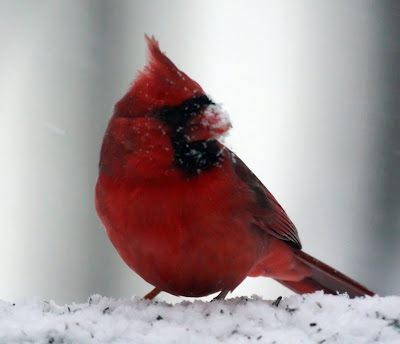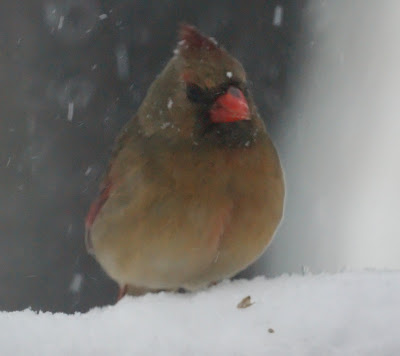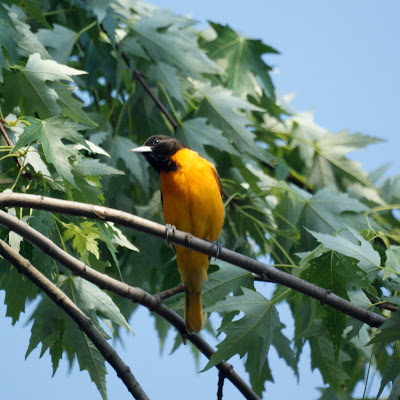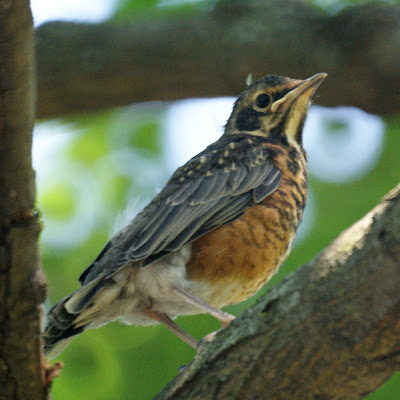A few weeks ago during a heavy snow storm, a neighbor's tree fell into the lake. Now that parts of the lake are unfrozen, it is providing good shelter for some wood ducks. Here, two male wood ducks are vying for the attention of a single female. We're glad to see these less frequent visitors and hope they are a harbinger for spring.
Sunday, February 28, 2010
Wood Ducks Visit Lake Nelson
A few weeks ago during a heavy snow storm, a neighbor's tree fell into the lake. Now that parts of the lake are unfrozen, it is providing good shelter for some wood ducks. Here, two male wood ducks are vying for the attention of a single female. We're glad to see these less frequent visitors and hope they are a harbinger for spring.
Isn't spring here yet?: Photo by Gene and Lynne
A Red Bellied Woodpecker, I've been waiting to catch a picture of. He's been coming around for about a month now.
Friday, February 26, 2010
Winter is still here
The latest snow storm seems particularly difficult for the birds. We've had many more at the feeders. The cardinals that are usually too skittish to come to our deck for food joined the finches and the juncos for some nyjer seed.
Wednesday, February 24, 2010
We're ready for Spring
Here are some photos from last spring. We are tired of the winter weather, the snow and the rain. We are looking forward to spring when the orioles return, the goldfinches are brighter, and there are baby birds around.
Tuesday, February 16, 2010
Virginia Rail: Photo by Greg
Virginia Rail seen Feb. 12th. at The Celery Farm in Allendale. Observed it for about 45 minutes from distances as close as 10 feet!! A very cooperative little bird & a lifer for me!
Thanks - Greg (Clifton, NJ)
American woodcock: Photo by Denise
I am sending this in hoping that someone will know what kind of bird this is. This is the first time I've ever seen this bird in my yard. Actually this is one of a pair. It's got a very long pointy bill that it uses to burrough into the ground. Looks to me like it's hunting for insects rather than a bird that goes for seeds etc..
It wasn't too afraid of me as I crept up on him and was only about 15 feet from it when I snapped the picture.
He actually seemed to pose for me.
---
Denise,
This is an American Woodcock. They mainly eat worms and other insects. They are leaving their usual spots due to the high snow and searching for food.
-Mike & Chris
Monday, February 15, 2010
Two Carolina Wrens at the Suet Feeder
Saturday, February 13, 2010
Thursday, February 11, 2010
Winter birds: Tufted Titmouse and Chickadee
Tufted Titmouse
Chickadee
The ice and snow has changed the feeding pattern a bit. A chickadee came to the deck to eat and we've seen chickadees, nuthatches, wrens as well as the usual woodpeckers at the suet feeders.
Snow Birds
Some birds head south for the winter; others adapt to the New Jersey winter with the cold and snow. We do make sure we have plenty of food out for the birds. In the top photo, a Carolina wren takes refuge in the duck house we put up (that no duck has ever used). In the middle, a sparrow digs through the snow for some seed. We did clear the railing and leave some seed, but it quickly got covered. In the bottom photo, a red bellied woodpecker enjoys a peanut.
Wednesday, February 10, 2010
Red-bellied Woodpecker: Photo by Jennifer
I took this photo 2/6/2010 from my back yard. I waited for two weeks to capture this bird but I think I got it at the right time.
Tuesday, February 9, 2010
Painted Buntings
We started with a plan to escape the cold for a long weekend and then added a quest: to see a painted bunting (which also heads south for the winter). We found the Painted Bunting Observer Team and asked:
We're planning a vacation in mid February to somewhere warm. An added bonus would be a location that has painted buntings. Can you recommend a spot that is fairly reliable for this bird.
We quickly got back the following reply.
Well, that is a wonderfully open-ended plan - I am envious of your flexibility!
Painted Buntings are in residence on both coasts of Florida from around the latitude of Orlando south all the way to the Keys. If you have a specific destination in mind, I highly recommend you call the local Audubon that covers that area (http://www.audubon.org/states/index.php?state=FL). In general, there are many State Parks, nature centers and learning centers along the east coast that maintain feeders for Painted Buntings. You could try (in north to south order): the Merritt Island National Wildlife Refuge near Titusville; Environmental Learning Center in Vero Beach; the Okeeheelee Nature Center in West Palm Beach (I know for sure they have Painted Buntings at their feeders); and Castellow Hammock Preserve south of Miami (Homestead area). On the west coast, Corkscrew Swamp Sanctuary in Naples has been reporting Painted Buntings at their feeders all winter.
Because Painted Buntings are fairly predictable visitors to the feeder, the staff at any of these facilities should know if they have Painted Buntings, and also at what times of day they are most likely to be feeding (usually dawn to around 8 a.m. and again at dusk). You will definitely improve your chances of seeing one of these beautiful birds if you call ahead!
I hope you have a great adventure, warm up thoroughly, and get to see some of the beautiful birds on your southern travels! Please let me know if I can help you any further! Leah
-----
Leah Fuller
Program Coordinator
www.paintedbuntings.org
We decided upon Naples and headed south. Corkscrew Swamp Sanctuary is a great spot for birding. We did find the painted buntings, and as an added bonus the pileated woodpeckers were very active, including one that spent 15 minutes extracting insects from a tree near the painted bunting feeder. It took a while to photograph the buntings. They mostly flew straight to the feeders (which are caged to keep the grackles away). The colorful male and the less colorful but also lovely female each had a spot where they would briefly stop and eventually we saw both. You don't want to know how many hours we logged at this task, but at least we were out in the warm weather, and there were a lot of other nice birders around to share stories with.
With the winter weather in New Jersey, we picked the right time to go away, but we're barely back and thinking we may have come back too soon.
Thanks Leah for the suggestions! We had a great time.
P.S. our next quest is the scarlet tanager.
Pileated Woodpecker: Corkscrew Swamp Sanctuary, Naples FL
The pileated woodpecker is an amazing bird to watch. We observed one for about 15 minutes (while staking out the painted buntings.) It was the loud tap, tap that got our attention even though our backs were turned to where it was. Later in a different area, there were three making great showings, and they are just as beautiful in flight as they are to watch on the trees. We know we have posted a few too many, but it's hard to choose. The photos are of three different woodpeckers. We think its head looks like a troll doll in the second photo, and you can see the bark and wood chips are flying in the fourth. You can see his tongue in the last.
We'll post more later from Corkscrew, the beach, and another park we visited that is part of the Great Florida Birding Trail.
On a non-bird related topic, although bird watchers do have to eat so maybe it's on topic, we have to give a shout out to Simply Cupcakes in Naples. What nice people and great cupcakes! We highly recommend stopping in if you're in the area sometime. Last month while in Ft. Lauderdale, we checked out an Oprah favorite and a place we had seen on the Food Channel called We Take the Cake. Well, in our opinion, they don't take the cake at all compared to Simply Cupcakes.
Florida Herons
A few Black Crowned Night Herons and Green Herons spend their summer at Lake Nelson in Piscataway. We had to go to Florida to see them in the winter. There were also Great Blue Herons and Great Egrets but they were too plentiful to photograph. We took the night heron's photo at Corkscrew Swamp Sanctuary and the green heron's at Eagle Lakes Community Park in Naples.
Labels:
Black-crowned Night Heron,
Florida,
Green Heron
Florida Beach Birds
Mike has been wanting to see a black skimmer in New Jersey. No luck yet, but there were many visible from the hotel balcony in Naples.
Labels:
Black Skimmer,
Brown Pelican,
Florida Iguana,
Royal Tern
Birds from Eagle Lakes Community Park in Naples
Eagle Lakes Community Park in Naples was a good spot to see some of the more common birds.
Labels:
Blue-Winged Teal,
Florida,
Glossy Ibis,
Pied Billed Grebe,
Wood Stork
Monday, February 8, 2010
I have the feeling we're not in Kansas anymore
The docent at Corkscrew swamp told us that the Saddleback Caterpillar is a rare venomous caterpillar. We suppose that's better than a common venomous caterpillar.
No trip to Florida is complete without an alligator sighting.
Subscribe to:
Comments (Atom)







